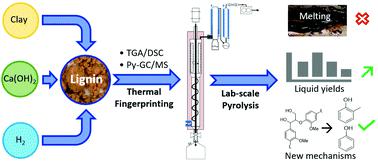当前位置:
X-MOL 学术
›
Green Chem.
›
论文详情
Our official English website, www.x-mol.net, welcomes your
feedback! (Note: you will need to create a separate account there.)
Improving fast pyrolysis of lignin using three additives with different modes of action
Green Chemistry ( IF 9.3 ) Pub Date : 2020-08-24 , DOI: 10.1039/d0gc02417a Stef Ghysels 1, 2, 3, 4, 5 , Ben Dubuisson 1, 2, 3, 4, 5 , Mehmet Pala 1, 2, 3, 4, 5 , Léon Rohrbach 6, 7, 8, 9 , Jan Van den Bulcke 3, 4, 5, 10, 11 , Hero Jan Heeres 6, 7, 8, 9 , Frederik Ronsse 1, 2, 3, 4, 5
Green Chemistry ( IF 9.3 ) Pub Date : 2020-08-24 , DOI: 10.1039/d0gc02417a Stef Ghysels 1, 2, 3, 4, 5 , Ben Dubuisson 1, 2, 3, 4, 5 , Mehmet Pala 1, 2, 3, 4, 5 , Léon Rohrbach 6, 7, 8, 9 , Jan Van den Bulcke 3, 4, 5, 10, 11 , Hero Jan Heeres 6, 7, 8, 9 , Frederik Ronsse 1, 2, 3, 4, 5
Affiliation

|
Lignin holds the potential to obtain key monoaromatic compounds upon its depolymerization. Depolymerization of woody biomass by pyrolysis is well established but often unsuccessful for lignin due to a combination of its melting, agglomeration, and modest yields towards aromatics. Therefore, several lignin additives have been put forth to overcome one or more of these hurdles. Although some seem promising, a direct comparison is obscured by differences in applied technical lignin types, reactor configurations/scales, and product analyses. Moreover, the effects of additives have either been evaluated mostly on an analytical scale or their mode of action is not entirely understood. This work involves the addition of clays, calcium hydroxide and sodium formate to lignin, each having a different (putative) mode of action, in a well-defined and comparable manner. Organosolv lignin and lignin with additives were analysed by TGA/DSC and py-GC/MS. Pyrolysis was performed in a lab-scale reactor (350 g feeding). The pyrolysis liquids were characterised through elemental analysis, GCxGC-FID, GCxGC-HR-ToF-MS, GPC, and HSQC NMR analyses. All additives overcame melting issues and led to increased liquid yields but the most promising were attapulgite and calcium hydroxide. Lignin with attapulgite resulted in a heavy phase with the highest carbon yield (25.7%) and a substantial monomer yield (18.9%, mostly alkylphenols). Lignin with calcium hydroxide resulted in a heavy phase with the highest monomer yield (23.8%, mostly alkylphenols) at a substantial carbon yield (15.1%). The pyrolysis mechanisms for lignins with additives are elaborated and updated in this work.
中文翻译:

使用三种具有不同作用方式的添加剂改善木质素的快速热解
木质素具有解聚后获得关键单芳族化合物的潜力。木质生物质通过热解解聚的方法已经很成熟,但是由于木质素的熔化,团聚和对芳烃的适度收率的结合,木质素通常不成功。因此,已经提出了几种木质素添加剂以克服这些障碍中的一个或多个。尽管有些看似有希望,但直接的比较因所应用的技术木质素类型,反应器配置/规模和产品分析的差异而被遮掩。而且,添加剂的作用要么主要在分析规模上进行评估,要么它们的作用方式尚不完全清楚。这项工作涉及向木质素中添加粘土,氢氧化钙和甲酸钠,每种都具有不同的(可能的)作用方式,以明确且可比的方式。通过TGA / DSC和py-GC / MS分析有机溶剂木质素和具有添加剂的木质素。在实验室规模的反应器中进行热解(进料量为350 g)。通过元素分析,GCxGC-FID,GCxGC-HR-ToF-MS,GPC和HSQC NMR分析对热解液进行了表征。所有添加剂克服了熔化问题,导致液体产率提高,但最有前景的是凹凸棒石和氢氧化钙。带有凹凸棒石的木质素导致重相具有最高的碳收率(25.7%)和大量的单体收率(18.9%,主要是烷基酚)。木质素与氢氧化钙形成重相,单体收率最高(23.8%,主要是烷基酚),而碳收率很高(15.1%)。木质素与添加剂的热解机理在这项工作中得到了详细阐述和更新。通过TGA / DSC和py-GC / MS分析有机溶剂木质素和具有添加剂的木质素。在实验室规模的反应器中进行热解(进料量为350 g)。通过元素分析,GCxGC-FID,GCxGC-HR-ToF-MS,GPC和HSQC NMR分析对热解液进行了表征。所有添加剂都克服了熔化问题,导致液体产率提高,但最有希望的是凹凸棒石和氢氧化钙。带有凹凸棒石的木质素导致重相具有最高的碳收率(25.7%)和大量的单体收率(18.9%,主要是烷基酚)。木质素与氢氧化钙形成重相,单体收率最高(23.8%,主要是烷基酚),而碳收率很高(15.1%)。木质素与添加剂的热解机理在这项工作中得到了详细阐述和更新。通过TGA / DSC和py-GC / MS分析有机溶剂木质素和具有添加剂的木质素。在实验室规模的反应器中进行热解(进料量为350 g)。通过元素分析,GCxGC-FID,GCxGC-HR-ToF-MS,GPC和HSQC NMR分析对热解液进行了表征。所有添加剂克服了熔化问题,导致液体产率提高,但最有前景的是凹凸棒石和氢氧化钙。带有凹凸棒石的木质素导致重相具有最高的碳收率(25.7%)和大量的单体收率(18.9%,主要是烷基酚)。木质素与氢氧化钙形成重相,单体收率最高(23.8%,主要是烷基酚),而碳收率很高(15.1%)。木质素与添加剂的热解机理在这项工作中得到了详细阐述和更新。
更新日期:2020-10-05
中文翻译:

使用三种具有不同作用方式的添加剂改善木质素的快速热解
木质素具有解聚后获得关键单芳族化合物的潜力。木质生物质通过热解解聚的方法已经很成熟,但是由于木质素的熔化,团聚和对芳烃的适度收率的结合,木质素通常不成功。因此,已经提出了几种木质素添加剂以克服这些障碍中的一个或多个。尽管有些看似有希望,但直接的比较因所应用的技术木质素类型,反应器配置/规模和产品分析的差异而被遮掩。而且,添加剂的作用要么主要在分析规模上进行评估,要么它们的作用方式尚不完全清楚。这项工作涉及向木质素中添加粘土,氢氧化钙和甲酸钠,每种都具有不同的(可能的)作用方式,以明确且可比的方式。通过TGA / DSC和py-GC / MS分析有机溶剂木质素和具有添加剂的木质素。在实验室规模的反应器中进行热解(进料量为350 g)。通过元素分析,GCxGC-FID,GCxGC-HR-ToF-MS,GPC和HSQC NMR分析对热解液进行了表征。所有添加剂克服了熔化问题,导致液体产率提高,但最有前景的是凹凸棒石和氢氧化钙。带有凹凸棒石的木质素导致重相具有最高的碳收率(25.7%)和大量的单体收率(18.9%,主要是烷基酚)。木质素与氢氧化钙形成重相,单体收率最高(23.8%,主要是烷基酚),而碳收率很高(15.1%)。木质素与添加剂的热解机理在这项工作中得到了详细阐述和更新。通过TGA / DSC和py-GC / MS分析有机溶剂木质素和具有添加剂的木质素。在实验室规模的反应器中进行热解(进料量为350 g)。通过元素分析,GCxGC-FID,GCxGC-HR-ToF-MS,GPC和HSQC NMR分析对热解液进行了表征。所有添加剂都克服了熔化问题,导致液体产率提高,但最有希望的是凹凸棒石和氢氧化钙。带有凹凸棒石的木质素导致重相具有最高的碳收率(25.7%)和大量的单体收率(18.9%,主要是烷基酚)。木质素与氢氧化钙形成重相,单体收率最高(23.8%,主要是烷基酚),而碳收率很高(15.1%)。木质素与添加剂的热解机理在这项工作中得到了详细阐述和更新。通过TGA / DSC和py-GC / MS分析有机溶剂木质素和具有添加剂的木质素。在实验室规模的反应器中进行热解(进料量为350 g)。通过元素分析,GCxGC-FID,GCxGC-HR-ToF-MS,GPC和HSQC NMR分析对热解液进行了表征。所有添加剂克服了熔化问题,导致液体产率提高,但最有前景的是凹凸棒石和氢氧化钙。带有凹凸棒石的木质素导致重相具有最高的碳收率(25.7%)和大量的单体收率(18.9%,主要是烷基酚)。木质素与氢氧化钙形成重相,单体收率最高(23.8%,主要是烷基酚),而碳收率很高(15.1%)。木质素与添加剂的热解机理在这项工作中得到了详细阐述和更新。











































 京公网安备 11010802027423号
京公网安备 11010802027423号